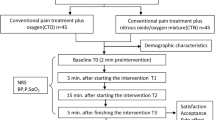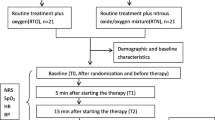Abstract
Background and objective
Although an equimolar mix of nitrous oxide-oxygen (N2O/O2) [Kalinox®] is widely used as an analgesic, there have been few specific studies of this product in the elderly. In this article, we investigate the tolerability of this equimolar mix in very elderly patients undergoing painful procedures.
Methods
This was a prospective, observational study of patients hospitalised in the geriatric short-stay unit of a teaching hospital between July 2001 and September 2003. All patients aged ≥80 years who were scheduled for invasive care procedures were eligible for inclusion. Sixty-two patients were recruited and underwent a total of 68 procedures. The procedures were divided into four classes based on the degree of pain they were expected to cause and their duration. Patients received the equimolar N2O/O2 mix (Kalinox®) for 5 minutes before the beginning of the procedure and throughout its duration. The inhaled treatment was administered via a high-concentration mask. Assessments were carried out during the inhalation and over the 15 minute period following inhalation. The primary endpoint of the study was tolerability of the equimolar N2O/O2 mix, and all adverse events were recorded. Secondary endpoints were the efficacy of the product (assessed on a verbal rating scale and/or the Doloplus scale), its ease of use and its acceptability to patients and staff.
Results
Fourteen patients (22.6%) each reported at least one adverse event: impaired hearing (n = 1), altered perception of the environment (n = 8), anxiety (n = 1), headache (n = 3) and drowsiness at the end of the procedure (n = 2). All these disorders subsided rapidly after treatment was completed.
Conclusion
This study shows the favourable tolerability of the equimolar N2O/O2 mix in very elderly subjects, which makes this product a valuable tool for the management of acute pain in this age group.



Similar content being viewed by others
Notes
The use of trade names is for product identification purposes only and does not imply endorsement.
References
Richet-Mastain L. 2004 population report: net decrease in death rates. Insee [online]. Available from URL: http://www.insee.fr/en/ffc/docs_ffc/IP1004en.pdf [Accessed 2007 Apr 27]
Gibson SJ, Farrell M. A review of age differences in the neurophysiology of nociception and the perceptual experience of pain. Clin J Pain 2004 Jul–Aug; 20(4): 227–39
Gloth FM. Pain management in older adults: prevention and treatment. J Am Geriatr Soc 2001 Feb; 49(2): 188–99
Helme RD, Gibson SJ. The epidemiology of pain in elderly people. Clin Geriatr Med 2001 Aug; 17(3): 417–31
Foley KM. Pain management in the elderly. In: Hazzard WR, Bierman EL, Blass JP, et al., editors. Principles of geriatric medicine and gerontology. New York: McGraw-Hill, 1994: 317–31
Pickering G, Jourdan D, Dubray C. Acute versus chronic pain treatment in Alzheimer’s disease. Eur J Pain 2006 May; 10(4): 379–84
Pautex S, Michon A, Guedira M, et al. Pain in severe dementia: self-assessment or observational scales. J Am Geriatr Soc 2006 Jul; 54(7): 1040–5
Wary B, Doloplus C. Doloplus-2, a scale for pain measurement [in French]. Soins Gerontol 1999; 19: 25–7
Zwakhalen SM, Hamers JP, Berger MP. The psychometric quality and clinical usefulness of three pain assessment tools for elderly people with dementia. Pain 2006; 126(1–3): 210–20
Griffin GC, Campbell VD, Jones R. Nitrous oxide-oxygen sedation for minor surgery: experience in a pediatric setting. JAMA 1981 Jun 19; 245(23): 2411–3
Burton JH, Auble TE, Fuchs SM. Effectiveness of 50% nitrous oxide/50% oxygen during laceration repair in children. Acad Emerg Med 1998 Feb; 5(2): 112–7
Douillard V, D’Avigneau J, Cledat Y. Use of the equimolar oxygen-nitrous oxide mix for painful procedures in geriatrics [in French]. Rev Ger 2002; 27: 45–52
Bozygit A, Hached D, Kiffel C, et al. Intérêt, limites d’utilisation et tolérance du mélange équimolaire protoxyde d’azoteoxygène pour les actes douloureux en gériatrie. Douleurs 2005; 6: 238–46
Coviaux F, Goffart O, Yves-Deville C, et al. Indications and instructions for the use of the oxygen-nitrous mix in geriatric care [in French]. Rev Ger 2002; 27: 273–6
Hennequin M, Onody P. Pollution level during inhalation sedation with a 50% N2O/50% O2 premix: comparison of two administration devices [in French]. Ann Fr Anesth Reanim 2004 Oct; 23(10): 959–65
Autorisation de Mise sur le Marché. Afssaps [online]. Available from URL: http://afssaps-prd.afssaps.fr/php/ecodex/extrait.php?.specid=67577233 [Accessed 2007 May 18]
Arfeen Z, Armstrong PJ, Whitfield A. The effects of Entonox and epidural analgesia on arterial oxygen saturation of women in labour. Anesthesia 1994 Jan; 49(1): 32–4
Lawler K. Entonox: too useful to be limited to childbirth? Prof Care Mother Child 1995; 5(1): 19–21
Onody P, Gil P, Hennequin M. Safety of inhalation of a 50% nitrous oxide/oxygen premix: a prospective survey of 35 828 administrations. Drug Saf 2006; 29(7): 633–40
Annequin D, Carbajal R, Chauvin P, et al. Fixed 50% nitrous oxide oxygen mixture for painful procedures: a French survey. Pediatrics 2000 Apr; 105(4): E47
Keating HJ, Kundrat M. Patient-controlled analgesia with nitrous oxide in cancer pain. J Pain Symptom Manage 1996 Feb; 11(2): 126–30
Owen JA, Sitar DS, Berger L, et al. Age-related morphine kinetics. Clin Pharmacol Ther 1983 Sep; 34(3): 364–8
Hennequin M, Manière MC, Albecker-Grappe S, et al. A prospective multicentric trial for effectiveness and tolerance of a N2O/O2 premix used as a sedative drug. J Clin Psychopharmacol 2004 Oct; 24(5): 552–4
Harding TA, Gibson JA. The use of inhaled nitrous oxide for flexible sigmoidoscopy: a placebo-controlled trial. Endoscopy 2000 Jun; 32(6): 457–60
Forbes GM, Collins BJ. Nitrous oxide for colonoscopy: a randomized controlled study. Gastrointest Endosc 2000 Mar; 51(3): 271–7
Akrofi M, Miller S, Colfar S, et al. A randomized comparison of three methods of analgesia for chest drain removal in post-cardiac surgical patients. Anesth Analg 2005 Jan; 100(1): 205–9
Evans A. Use of Entonox in the community for control of procedural pain. Br J Community Nurs 2003 Nov; 8(11): 488–94
Atassi K, Mangiapan G, Fuhrman C, et al. Prefixed equimolar nitrous oxide and oxygen mixture reduces discomfort during flexible bronchoscopy in adult patients: a randomized, controlled, double-blind trial. Chest 2005 Aug; 128(2): 863–8
Corboy JM. Nitrous oxide analgesia for outpatient surgery. J Am Intraocul Implant Soc 1984 Spring; 10(2): 232–4
Castera L, Negre I, Samii K, et al. Patient-administered nitrous oxide/oxygen inhalation provides safe and effective analgesia for percutaneous liver biopsy: a randomized placebo-controlled trial. Am J Gastroenterol 2001 May; 96(5): 1553–7
Long JA, Manel A, Moalic R, et al. Use of MEOPA (nitrogen monoxide-oxygen mixture) as analgesic for prostate biopsies [in French]. Prog Urol 2004 Dec; 14(6): 1167–70
Acknowledgements
No sources of funding were used to assist in the preparation of this study. Medication and high-concentration masks used in this study were provided by Air Liquide Santé International. The authors have no conflicts of interest that are directly relevant to the content of this study.
Author information
Authors and Affiliations
Corresponding author
Rights and permissions
About this article
Cite this article
Bauer, C., Lahjibi-Paulet, H., Somme, D. et al. Tolerability of an Equimolar Mix of Nitrous Oxide and Oxygen during Painful Procedures in Very Elderly Patients. Drugs Aging 24, 501–507 (2007). https://doi.org/10.2165/00002512-200724060-00006
Published:
Issue Date:
DOI: https://doi.org/10.2165/00002512-200724060-00006




